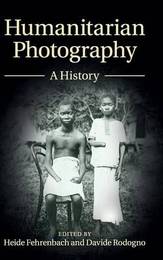
|
Humanitarian Photography: A History
Hardback
Main Details
| Title |
Humanitarian Photography: A History
|
| Authors and Contributors |
Edited by Heide Fehrenbach
|
|
Edited by Davide Rodogno
|
| Series | Human Rights in History |
|---|
| Physical Properties |
| Format:Hardback | | Pages:366 | | Dimensions(mm): Height 229,Width 152 |
|
| Category/Genre | World history |
|---|
| ISBN/Barcode |
9781107064706
|
| Classifications | Dewey:779.936126 |
|---|
| Audience | | Professional & Vocational | |
|---|
| Illustrations |
60 Halftones, black and white
|
|
Publishing Details |
| Publisher |
Cambridge University Press
|
| Imprint |
Cambridge University Press
|
| Publication Date |
23 February 2015 |
| Publication Country |
United Kingdom
|
Description
For well over a century, humanitarians and their organizations have used photographic imagery and the latest media technologies to raise public awareness and funds to alleviate human suffering. This volume examines the historical evolution of what we today call 'humanitarian photography' - the mobilization of photography in the service of humanitarian initiatives across state boundaries - and asks how we can account for the shift from the fitful and debated use of photography for humanitarian purposes in the late nineteenth century to our current situation in which photographers market themselves as 'humanitarian photographers'. This book investigates how humanitarian photography emerged and how it operated in diverse political, institutional, and social contexts, bringing together more than a dozen scholars working on the history of humanitarianism, international organizations and nongovernmental organizations, and visual culture in Africa, Asia, the Middle East, Europe, and the United States.
Author Biography
Heide Fehrenbach is Board of Trustees Professor and Distinguished Research Professor in the history department at Northern Illinois University. She is the author of three books: Cinema in Democratizing Germany, Race after Hitler: Black Occupation Children in Postwar Germany and America and After the Nazi Racial State: Difference and Democracy in Germany and Europe (with Rita Chin, Geoff Eley, and Atina Grossmann). She is also co-editor, with Uta Poiger, of Transactions, Transgressions, Transformations: American Culture in Western Europe and Japan (2000). Davide Rodogno is Professor of International History at the Graduate Institute of International and Developmental Studies in Geneva, Switzerland. His books include Fascism's European Empire, Against Massacre: Humanitarian Interventions in the Ottoman Empire, 1815-1914, and, as co-editor, Shaping the Transnational Sphere: Transnational Networks of Experts in the Long Nineteenth Century.
Reviews'This beautifully edited volume shows how absolutely central visual culture must be to our understanding of modern humanitarianism. Whether on atrocity, famine, or genocide, these essays explore photography's enduring power to shape the moral and political dynamics of international crises.' J. P. Daughton, Stanford University 'This collection of essays offers a most inspiring conceptualization of the use of photography for humanitarian purposes - for all historians in the burgeoning field of humanitarianism and related subjects as well as for those working in media studies. It enriches contemporary debates on humanitarian aid and humanitarian intervention, which have been and are still being strongly shaped by the visual representation of suffering and relief.' Johannes Paulmann, Director, Leibniz Institute of European History, Mainz 'The history of humanitarian aid and of humanitarianism is closely associated with the development of modern media, yet few have demonstrated critically the role of a technology or aesthetic approach like this tightly edited volume under the stewardship of Heide Fehrenbach and Davide Rodogno. This book is a pioneering and essential read for anyone interested in the growth and globalization of humanitarian consciousness. The images this book contains remain as disturbing and as shocking as they were intended to be decades ago, but the text sets them back in their context and tells their hidden stories. The book is essential reading for all historians of the twentieth century and today's humanitarians who now have to represent sufferings without losing their own soul.' Bertrand Taithe, Humanitarian and Conflict Response Institute, University of Manchester 'The most important contribution of this volume is the development of a new historically useful concept with ramifications for the history of photography and, more broadly, for the visual history of the contemporary world ... By the end of the volume, readers will have gained a thorough historical overview of a distinct photographic practice, with case studies from Africa, Asia, the Middle East, Europe, and the United States.' Ana Maria Mauad, Society for U.S. Intellectual History, Book Reviews (https://s-usih.org/)
|